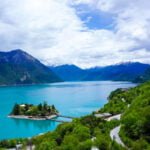Ponri Mountain, known as “Monkey Mountain” in Tibetan, stands majestically in the southeastern part of Bayi District, Nyingchi, alongside the northern banks of the Yarlung Tsangpo River. At an elevation of about 4500 meters, Ponri is not just a peak within the Sejila Mountain range; it is a revered site for followers of the Bon religion, Tibet’s ancient spiritual tradition.
A Land of Legends and Natural Splendour
According to legend, Ponri Mountain was where the Bon master Shenrab Miwoche achieved enlightenment and subdued demons. The mountain’s unique landscape, adorned with natural rock formations resembling Buddha heads, feet, hands, bodies, as well as imprints of tigers, horses, and donkeys, adds to its mystique. Surrounding the mountain are ancient Bon monasteries and sacred springs, making it a focal point for spiritual journeys.
The mountain’s flora and fauna are as diverse as its folklore. With a forest coverage rate of 55.1% over 100,000 hectares, Ponri boasts ancient cypresses, Himalayan firs, yew trees, and living fossil “tree ferns,” alongside a plethora of rhododendrons and broadleaf forests. It’s also home to rare medicinal herbs such as cordyceps, gastrodia elata, fritillaria, and snow lotus, contributing to its reputation as a natural treasure trove.
Celebrating Spirituality and Nature
Ponri Mountain is famous for its azaleas, with 25 varieties painting the landscape in vibrant hues from the base to the summit. During the Saga Dawa festival in the fourth Tibetan month, households from Nyingchi pilgrimage to Ponri, while in the eighth month, Bon followers from across Tibet gather for a grand circumambulation event, embracing the mountain’s sacred energy.
Visitor’s Guide
- Access: Ponri Mountain can be accessed by car from Bayi Town or by renting a horse from local villages. The ascent begins from Mirui Township, passing through sacred sites like Zongqiongdan Monastery and Qionglong Sacred Water.
- Accommodation: Visitors can stay at pilgrim guesthouses in Mirui Township or camp near the mountain’s northern water sources, though bringing necessary food and drinks is advised.
- Best Time to Visit: The ideal time to explore Ponri Mountain is from June to August when the lush forests and blooming azaleas create a breathtaking panorama, offering a unique opportunity to capture the beauty of Tibet’s sacred landscapes across all seasons.
Ponri Mountain encapsulates the essence of Tibet’s Bon tradition and natural beauty, inviting travelers to experience its spiritual significance and picturesque scenery.














